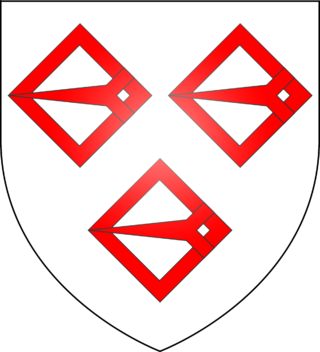
Earl of Winchilsea is a title in the Peerage of England. It has been held by the Finch-Hatton family of Kent, and united with the title of Earl of Nottingham under a single holder since 1729.

Baron Hastings is a title that has been created three times. The first creation was in the Peerage of England in 1290, and is extant. The second creation was in the Peerage of England in 1299, and became extinct on the death of the first holder in c. 1314. The third creation was in the Peerage of England in 1461, and has been in abeyance since 1960.

Baron Berners is a barony created by writ in the Peerage of England.

Baron Stafford, referring to the town of Stafford, is a title that has been created several times in the Peerage of England. In the 14th century, the barons of the first creation were made earls. Those of the fifth creation, in the 17th century, became first viscounts and then earls. Since 1913, the title has been held by the Fitzherbert family.

Frances Villiers, Countess of Jersey was a British courtier and Lady of the Bedchamber, one of the more notorious of the many mistresses of King George IV when he was Prince of Wales, "a scintillating society woman, a heady mix of charm, beauty, and sarcasm".

Bradbourne House is a Queen Anne style country house near East Malling, Kent. It set in 20 acres (81,000 m2) of parkland.

There have been two baronetcies created for members of the Dashwood family, one in the Baronetage of England and one in the Baronetage of Great Britain. Both creations are extant as of 2008.

The Jerningham Baronetcy, of Cossey in the County of Norfolk, was a title in the Baronetage of England. It was created on 16 August 1621 for Henry Jerningham. The 5th Baronet married Mary Plowden, only daughter of Mary Plowden, sister of John Paul Stafford-Howard, 4th Earl of Stafford and de jure 5th Baron Stafford. He was succeeded by his son, the sixth Baron. In 1807 the claim to the barony of Stafford, which had been under attainder since 1680, passed to him through his mother. He died in 1809 when the baronetcy and the claim to the barony passed to his son, the seventh Baronet. He petitioned the House of Lords for a reversal of the attainder of the barony of Stafford and for a writ of summons to Parliament. In 1824 the attainder was reversed and the following year he was summoned to the House of Lords as the eighth Baron Stafford.
The Bridges Baronetcy, of Goodnestone in the County of Kent, was created in the Baronetage of Great Britain on 19 April 1718 for Brook Bridges. His son the second Baronet, died in 1733 whilst in office as High Sheriff of Kent. His grandson, the third Baronet, represented Kent in the House of Commons. In 1842, the fifth Baronet, unsuccessfully claimed the ancient barony of FitzWalter as a descendant of Mary, sister of the seventeenth Baron FitzWalter. He later sat as a Member of Parliament for Kent East. In 1868 he was created Baron FitzWalter, of Woodham Walter in the County of Essex, in the Peerage of the United Kingdom. However, the peerage became extinct on his death, while he was succeeded in the baronetcy by his younger brother, the sixth Baronet. On his death the title passed to his first cousin, the seventh Baronet. He was the son of Reverend Brook Henry Bridges, third son of the third Baronet. When he died this line of the family also failed and the title was passed on to his first cousin, the eighth Baronet. He was the son of Reverend Brook Edward Bridges, fourth son of the third Baronet. He never married and on his death in 1899 the baronetcy became extinct.
Sir William Twysden, 3rd Baronet, of Roydon Hall in Kent, was an English landowner and member of parliament.
Sir Roger Twysden, 2nd Baronet, of Roydon Hall near East Peckham in Kent, was an English historian and politician who sat in the House of Commons at various times between 1625 and 1640.

The Mostyn baronets are two lines of Welsh baronets holding baronetcies created in 1660 and 1670, both in the Baronetage of England. One creation is extant as of 2015. The two lines are related and both claim descent from Edwin of Tegeingl, an 11th-century lord of Tegeingl, a territory which approximates modern Flintshire.
Sir Francis Barnham (1576–1646) was an English politician who sat in the House of Commons at various times between 1604 and 1646. He supported the Parliamentary cause in the English Civil War.
Sir Thomas Culpeper, 3rd Baronet, also known as Colepeper, of Preston Hall, Aylesford, Kent was an English landowner and Whig politician who sat in the English and British House of Commons between 1705 and 1723.
Sir Roger Twisden, 2nd Baronet was an English politician who sat in the House of Commons from 1689 to 1690.
Sir Thomas Twisden, 1st Baronet was an English lawyer and politician who sat in the House of Commons of England in two periods between 1646 and 1660. He was a High Court judge who presided at the trial of the regicides.
Sir William Twysden, 1st Baronet (1566–1628) was an English politician who sat in the House of Commons at various times between 1593 and 1628.
Philip Twysden (1713–1752), was an Anglican clergyman who served in the Church of Ireland as Lord Bishop of Raphoe from 1747 to 1752. The circumstances of his death later became the subject of scandalous rumour.

Lady Anne Twysden was an English writer. She was the mother of several notable children but she is known principally for one book, the original of which is lost.
Sir Roger Twisden, 5th Baronet was an English Tory politician.










